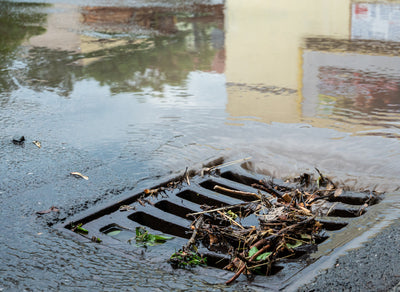How Does Stormwater Runoff Affect Drinking Water?
RSS
*Updated 3/2/22 to include recent study*
Analies Dyjak | Policy Nerd
Heavy rains and snowmelt can carry a lot of unwanted contaminants into drinking water sources. Here’s how stormwater runoff can affect your water.
How Does Stormwater Affect Drinking Water?
Heavy rain storms create a rapid influx of water, which can cause a host of health and environmental issues. Rainwater travels to low-lying bodies of water, including oceans, lakes, rivers, streams, and aquifers. Both surface and groundwater are susceptible to contamination from stormwater runoff, both of which are sources of drinking water. As water travels, it picks up loose debris, pesticides, herbicides, oil, and other types of pollution in its path. This cocktail of contaminants is then dumped into a nearby waterway. Some municipal water treatment facilities are equipped to deal with these types of contamination, while others are not. 86% of the U.S. population gets their drinking water from surface water sources, so maintaining clean lakes and rivers is extremely important for managing stormwater runoff pollution in drinking water.
Road Salt and Drinking Water Contamination
70% of the US population lives in areas that experience ice and snow, and rely heavily on road salts and other deicing techniques to maintain road safety. Road salts are crucial for decreasing automobile accidents, but they can have some unintended consequences on the environment. A recent study found that freshwater contamination from these deicing materials causing significant increases in the salinity of the freshwater, resulting in issues with native wildlife and widespread contamination of drinking water supplies. The contamination is primarily from excess chloride and sodium, which affects both surface water and groundwater, for municipal water suppliers as well as private wells. In addition, deicing salts can leach heavy metals (such as mercury, lead, cadmium, copper, and zinc) from sediment and plumbing pipes into the drinking water. In groundwater, sodium can also mobilize dissolved radium, increasing the risk of radon exposure to homeowners.
What Are Combined Sewer Overflows or CSO’s?
Combined Sewer Overflows or CSO’s, are a system of underground canals that collect stormwater runoff, industrial wastewater, and sewage all in the same pipe. Under normal conditions, stormwater and sewage travels to a wastewater plant where it’s treated before being discharged into a body of water. During heavy rain events, the large influx of stormwater causes pipes to exceed the capacity of the the system. Untreated wastewater, including sewage, overflows into nearby oceans, lakes, rivers or streams or wherever a stormwater discharge output exists. CSO’s were used as early as the 1850’s, and were the only system in place to deal with such high volumes of water. Many cities have replaced CSO’s with advanced infrastructure, but cities such as Portland, Maine and Cambridge, Massachusetts still use them.
Impervious Surfaces and Stormwater
Impervious surfaces are developed areas where water is unable to infiltrate into the earth. This typically refers to paved roads, roofs, and sidewalks. When water is unable to infiltrate, it flows into the nearest body of water or wastewater system. Impervious surfaces are of concern because water picks up and carries dangerous contaminants, then deposits pollution into drinking water sources. Impervious surfaces also increase the impacts from floods. Unable to percolate, water sits on top of paved roads, increasing the flood potential and presence of biological contamination. As communities continue to develop, the area of paved or impervious surface increases as well.
Wetlands: Important for Stormwater Retention
Wetlands offer remarkable protection from the impacts of flooding and other stormwater damages. Wetlands absorb incoming water and release it slowly, acting as a natural sponge. According to the U.S Army Corps of Engineers, the state wetland conservation along the Charles River in Boston, Massachusetts saved approximately $17 million in potential flood damage. Additionally, wetlands naturally filter stormwater runoff pollution. The fast-moving water is slowed by vegetation, which allows suspended sediment and pollution to fall to the bottom.
Other Articles We Think You Might Enjoy:Surface Water: What You Need To Know
Agricultural Runoff: Why It's A Problem And What's Being Done To Stop It
Nitrates In Drinking Water




